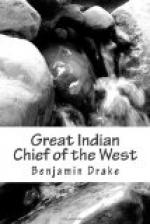Under the 9th article of the treaty of 1804, the United States agreed to establish a trading-house to supply the Sacs and Foxes with goods at a more reasonable rate than they had been accustomed to procure them. On the third of September 1822, Maj. Thomas Forsyth, the U.S. Indian agent, made a treaty at Fort Armstrong, with the chiefs, warriors and head men of the Sacs and Foxes, by which, in consideration of the sum of one thousand dollars, they forever released the United States from all obligation contained in said ninth article of the treaty of 1804.
On the fourth of August 1824, at Washington city, William Clark, Indian agent and sole commissioner of the United States, effected a treaty with the Sacs and Foxes through their chiefs and head men, by which, for the sum of one thousand dollars per annum for ten years, they ceded all their interest and title to any lands claimed by them in the state of Missouri, which are situated, lying and being between the Mississippi and Missouri rivers, and a line running from the Missouri at the entrance of Kansas river, north one hundred miles, to the north west corner of the state of Missouri, and from thence east to the Mississippi. By this treaty, these tribes acknowledged the land east and south of the lines above described, so far as the Indians claim the same, to belong to the United States, and that none of their tribes shall be permitted to settle or hunt upon any part of it, after the first day of January 1826, without permission from the Superintendent of Indian affairs.
Upon the 19th of August 1825, William Clark and Lewis Cass, Commissioners on behalf of the United States, concluded a treaty at Prairie du Chien, in the territory of Michigan, with the chiefs and warriors of the Sioux, Winnebagoes, Menominees, Chippewas, Ottawas, Pottawatamies, Sacs, Foxes and Ioways. The objects of this treaty were the restoration of peace among the Indian tribes, several of whom had been for some time waging war against each other; the settlement of boundary lines between these tribes respectively, and between them and the United States. The Commissioners succeeded in effecting a peace between the Sioux and Chippeways, and between the Sacs, Foxes and Ioways on the one part, and the Sioux on the other; and also in adjusting the boundary lines of the territory of each tribe to the satisfaction of all parties. Under this treaty nothing was asked by the United States nor was any thing granted to them: the character in which the government presented itself, being simply that of a pacificator.
The concourse of Indians assembled at this council was very great. About 3000 came to the council ground, clothed in their war dresses, and armed with bows, war-clubs and tomahawks. The Sacs and Foxes were the last to arrive, but were very imposing and warlike in their appearance when they reached the ground. They ascended the Mississippi, to Prairie du Chien, in a fleet of canoes, lashed together.




